2003 FORD FOCUS load capacity
[x] Cancel search: load capacityPage 121 of 216
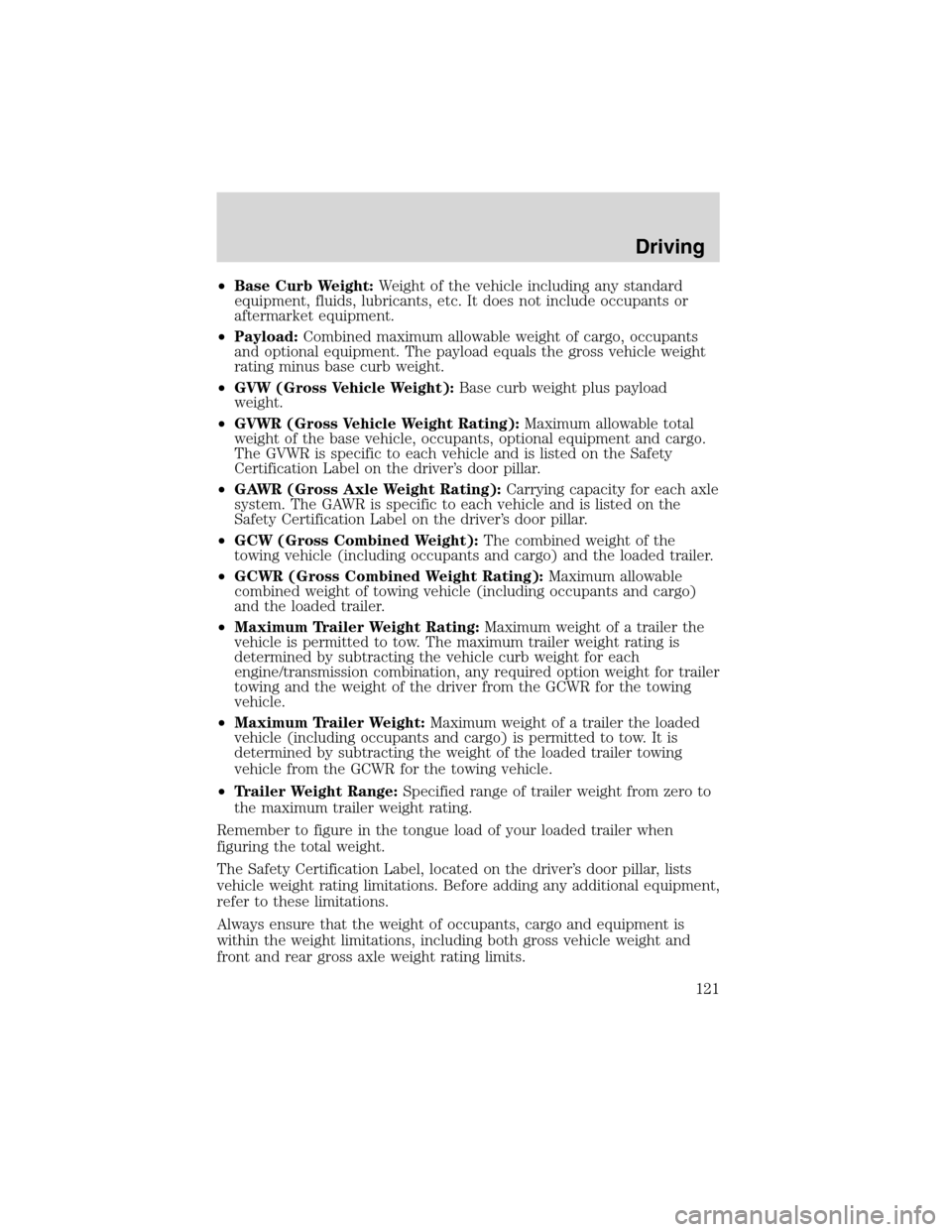
•Base Curb Weight:Weight of the vehicle including any standard
equipment, fluids, lubricants, etc. It does not include occupants or
aftermarket equipment.
•Payload:Combined maximum allowable weight of cargo, occupants
and optional equipment. The payload equals the gross vehicle weight
rating minus base curb weight.
•GVW (Gross Vehicle Weight):Base curb weight plus payload
weight.
•GVWR (Gross Vehicle Weight Rating):Maximum allowable total
weight of the base vehicle, occupants, optional equipment and cargo.
The GVWR is specific to each vehicle and is listed on the Safety
Certification Label on the driver’s door pillar.
•GAWR (Gross Axle Weight Rating):Carrying capacity for each axle
system. The GAWR is specific to each vehicle and is listed on the
Safety Certification Label on the driver’s door pillar.
•GCW (Gross Combined Weight):The combined weight of the
towing vehicle (including occupants and cargo) and the loaded trailer.
•GCWR (Gross Combined Weight Rating):Maximum allowable
combined weight of towing vehicle (including occupants and cargo)
and the loaded trailer.
•Maximum Trailer Weight Rating:Maximum weight of a trailer the
vehicle is permitted to tow. The maximum trailer weight rating is
determined by subtracting the vehicle curb weight for each
engine/transmission combination, any required option weight for trailer
towing and the weight of the driver from the GCWR for the towing
vehicle.
•Maximum Trailer Weight:Maximum weight of a trailer the loaded
vehicle (including occupants and cargo) is permitted to tow. It is
determined by subtracting the weight of the loaded trailer towing
vehicle from the GCWR for the towing vehicle.
•Trailer Weight Range:Specified range of trailer weight from zero to
the maximum trailer weight rating.
Remember to figure in the tongue load of your loaded trailer when
figuring the total weight.
The Safety Certification Label, located on the driver’s door pillar, lists
vehicle weight rating limitations. Before adding any additional equipment,
refer to these limitations.
Always ensure that the weight of occupants, cargo and equipment is
within the weight limitations, including both gross vehicle weight and
front and rear gross axle weight rating limits.
Driving
121
Page 183 of 216
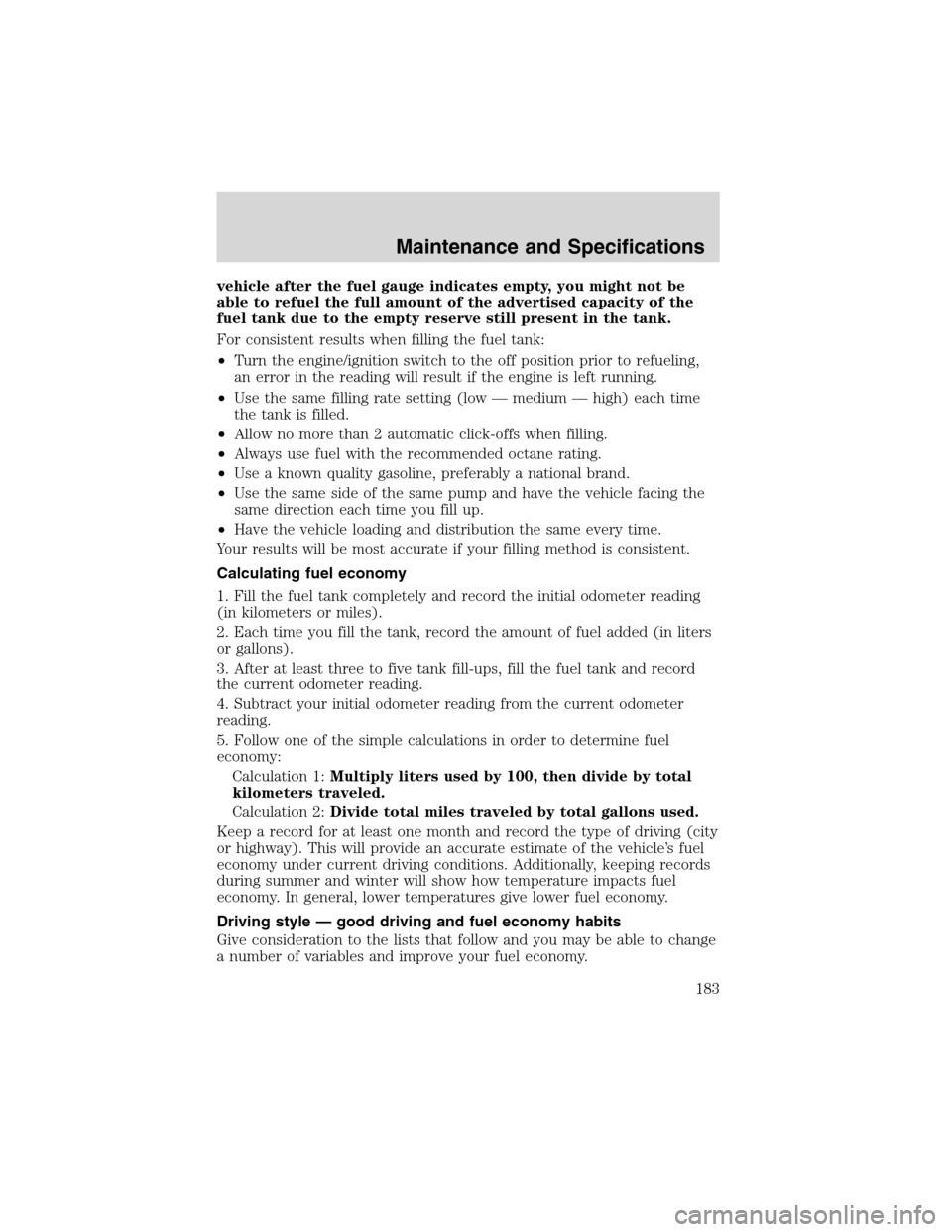
vehicle after the fuel gauge indicates empty, you might not be
able to refuel the full amount of the advertised capacity of the
fuel tank due to the empty reserve still present in the tank.
For consistent results when filling the fuel tank:
•Turn the engine/ignition switch to the off position prior to refueling,
an error in the reading will result if the engine is left running.
•Use the same filling rate setting (low—medium—high) each time
the tank is filled.
•Allow no more than 2 automatic click-offs when filling.
•Always use fuel with the recommended octane rating.
•Use a known quality gasoline, preferably a national brand.
•Use the same side of the same pump and have the vehicle facing the
same direction each time you fill up.
•Have the vehicle loading and distribution the same every time.
Your results will be most accurate if your filling method is consistent.
Calculating fuel economy
1. Fill the fuel tank completely and record the initial odometer reading
(in kilometers or miles).
2. Each time you fill the tank, record the amount of fuel added (in liters
or gallons).
3. After at least three to five tank fill-ups, fill the fuel tank and record
the current odometer reading.
4. Subtract your initial odometer reading from the current odometer
reading.
5. Follow one of the simple calculations in order to determine fuel
economy:
Calculation 1:Multiply liters used by 100, then divide by total
kilometers traveled.
Calculation 2:Divide total miles traveled by total gallons used.
Keep a record for at least one month and record the type of driving (city
or highway). This will provide an accurate estimate of the vehicle’s fuel
economy under current driving conditions. Additionally, keeping records
during summer and winter will show how temperature impacts fuel
economy. In general, lower temperatures give lower fuel economy.
Driving style—good driving and fuel economy habits
Give consideration to the lists that follow and you may be able to change
a number of variables and improve your fuel economy.
Maintenance and Specifications
183
Page 194 of 216
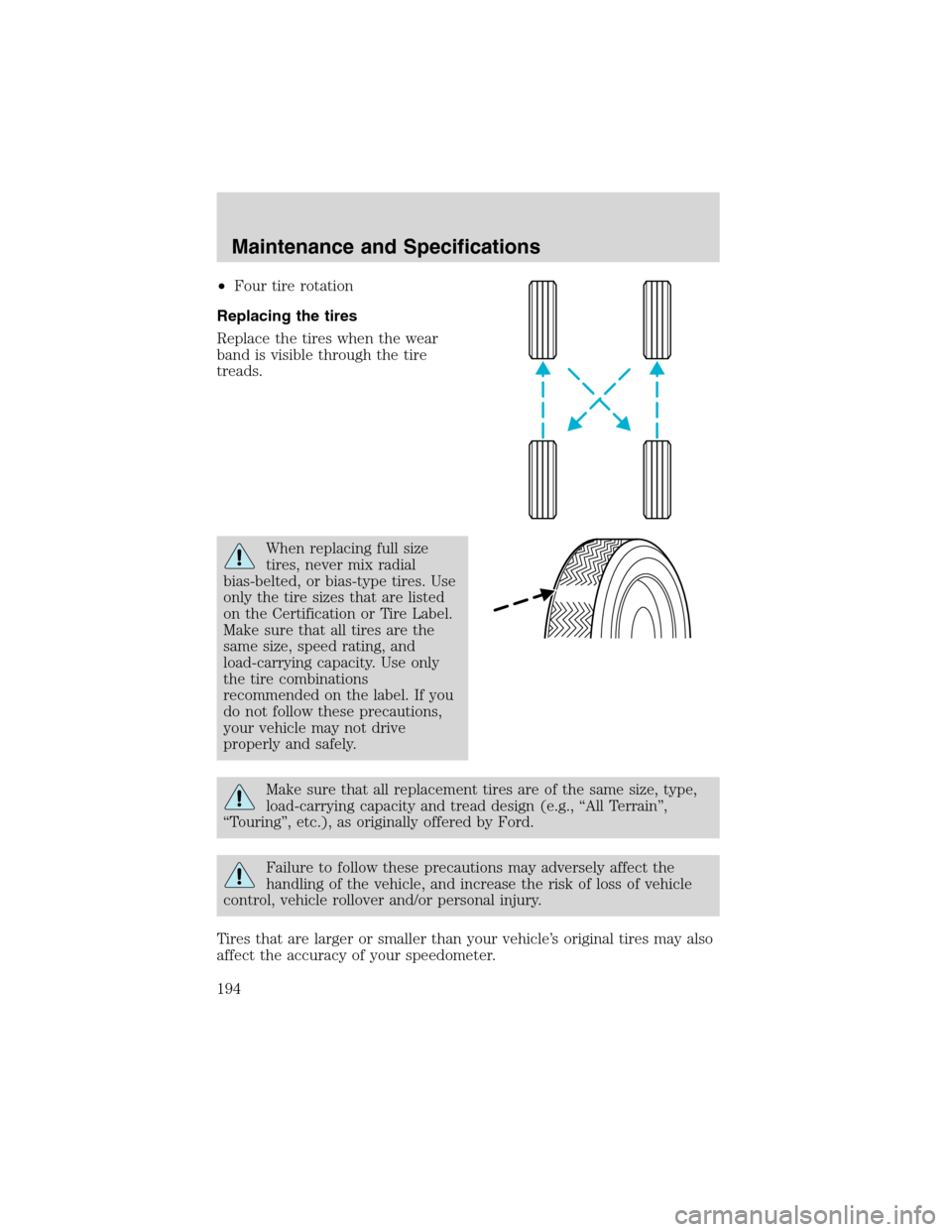
•Four tire rotation
Replacing the tires
Replace the tires when the wear
band is visible through the tire
treads.
When replacing full size
tires, never mix radial
bias-belted, or bias-type tires. Use
only the tire sizes that are listed
on the Certification or Tire Label.
Make sure that all tires are the
same size, speed rating, and
load-carrying capacity. Use only
the tire combinations
recommended on the label. If you
do not follow these precautions,
your vehicle may not drive
properly and safely.
Make sure that all replacement tires are of the same size, type,
load-carrying capacity and tread design (e.g.,“All Terrain”,
“Touring”, etc.), as originally offered by Ford.
Failure to follow these precautions may adversely affect the
handling of the vehicle, and increase the risk of loss of vehicle
control, vehicle rollover and/or personal injury.
Tires that are larger or smaller than your vehicle’s original tires may also
affect the accuracy of your speedometer.
Maintenance and Specifications
194
Page 210 of 216
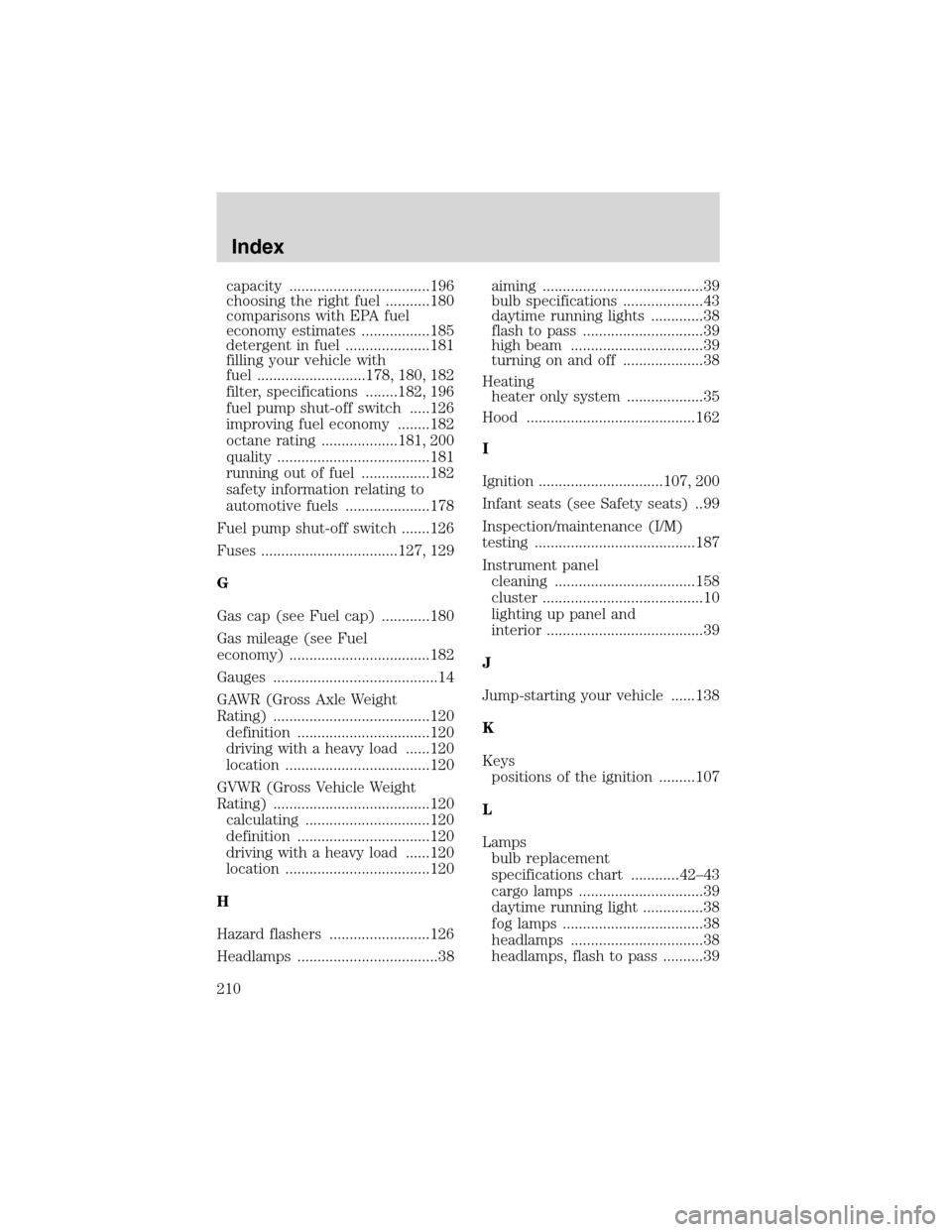
capacity ...................................196
choosing the right fuel ...........180
comparisons with EPA fuel
economy estimates .................185
detergent in fuel .....................181
filling your vehicle with
fuel ...........................178, 180, 182
filter, specifications ........182, 196
fuel pump shut-off switch .....126
improving fuel economy ........182
octane rating ...................181, 200
quality ......................................181
running out of fuel .................182
safety information relating to
automotive fuels .....................178
Fuel pump shut-off switch .......126
Fuses ..................................127, 129
G
Gas cap (see Fuel cap) ............180
Gas mileage (see Fuel
economy) ...................................182
Gauges .........................................14
GAWR (Gross Axle Weight
Rating) .......................................120
definition .................................120
driving with a heavy load ......120
location ....................................120
GVWR (Gross Vehicle Weight
Rating) .......................................120
calculating ...............................120
definition .................................120
driving with a heavy load ......120
location ....................................120
H
Hazard flashers .........................126
Headlamps ...................................38aiming ........................................39
bulb specifications ....................43
daytime running lights .............38
flash to pass ..............................39
high beam .................................39
turning on and off ....................38
Heating
heater only system ...................35
Hood ..........................................162
I
Ignition ...............................107, 200
Infant seats (see Safety seats) ..99
Inspection/maintenance (I/M)
testing ........................................187
Instrument panel
cleaning ...................................158
cluster ........................................10
lighting up panel and
interior .......................................39
J
Jump-starting your vehicle ......138
K
Keys
positions of the ignition .........107
L
Lamps
bulb replacement
specifications chart ............42–43
cargo lamps ...............................39
daytime running light ...............38
fog lamps ...................................38
headlamps .................................38
headlamps, flash to pass ..........39
Index
210
Page 211 of 216
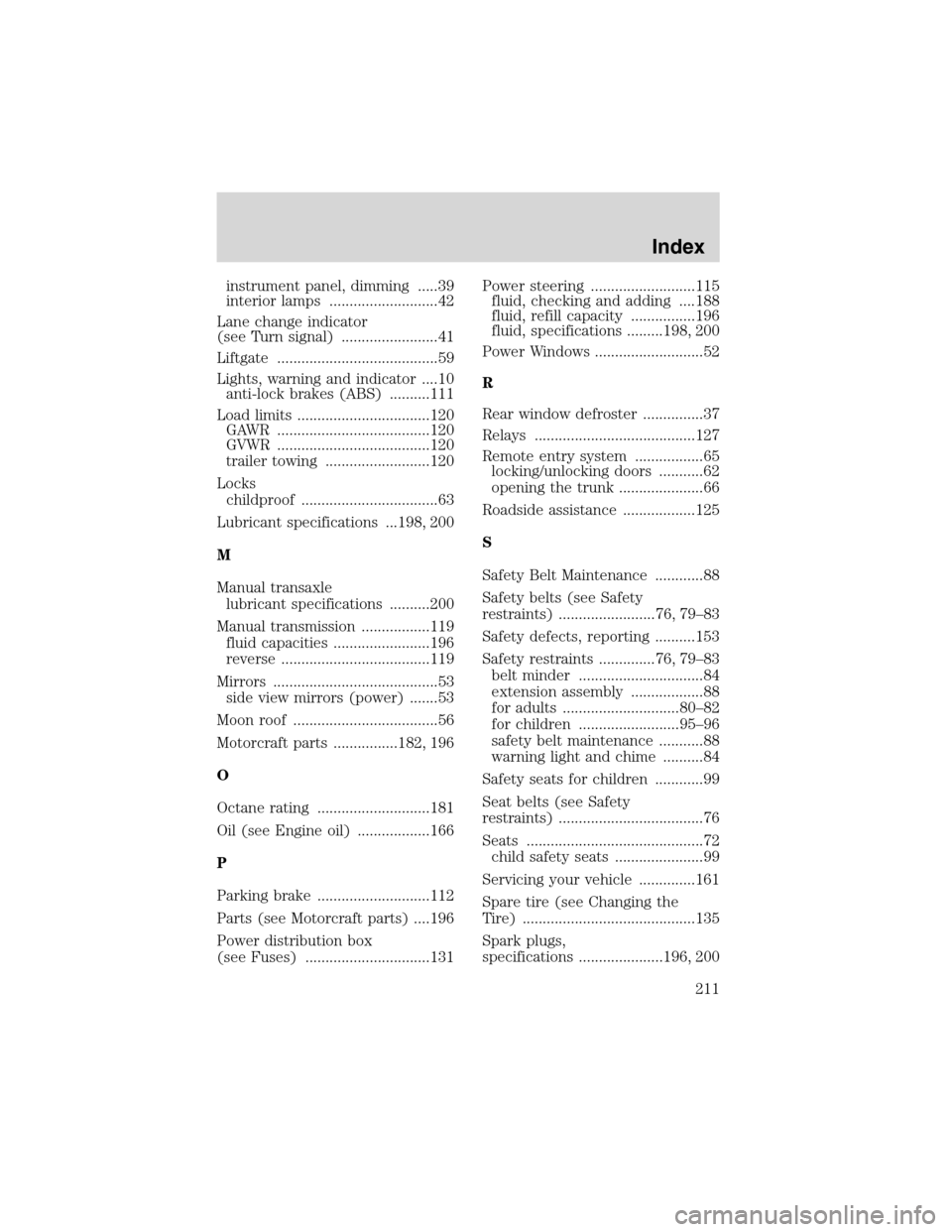
instrument panel, dimming .....39
interior lamps ...........................42
Lane change indicator
(see Turn signal) ........................41
Liftgate ........................................59
Lights, warning and indicator ....10
anti-lock brakes (ABS) ..........111
Load limits .................................120
GAWR ......................................120
GVWR ......................................120
trailer towing ..........................120
Locks
childproof ..................................63
Lubricant specifications ...198, 200
M
Manual transaxle
lubricant specifications ..........200
Manual transmission .................119
fluid capacities ........................196
reverse .....................................119
Mirrors .........................................53
side view mirrors (power) .......53
Moon roof ....................................56
Motorcraft parts ................182, 196
O
Octane rating ............................181
Oil (see Engine oil) ..................166
P
Parking brake ............................112
Parts (see Motorcraft parts) ....196
Power distribution box
(see Fuses) ...............................131Power steering ..........................115
fluid, checking and adding ....188
fluid, refill capacity ................196
fluid, specifications .........198, 200
Power Windows ...........................52
R
Rear window defroster ...............37
Relays ........................................127
Remote entry system .................65
locking/unlocking doors ...........62
opening the trunk .....................66
Roadside assistance ..................125
S
Safety Belt Maintenance ............88
Safety belts (see Safety
restraints) ........................76, 79–83
Safety defects, reporting ..........153
Safety restraints ..............76, 79–83
belt minder ...............................84
extension assembly ..................88
for adults .............................80–82
for children .........................95–96
safety belt maintenance ...........88
warning light and chime ..........84
Safety seats for children ............99
Seat belts (see Safety
restraints) ....................................76
Seats ............................................72
child safety seats ......................99
Servicing your vehicle ..............161
Spare tire (see Changing the
Tire) ...........................................135
Spark plugs,
specifications .....................196, 200
Index
211